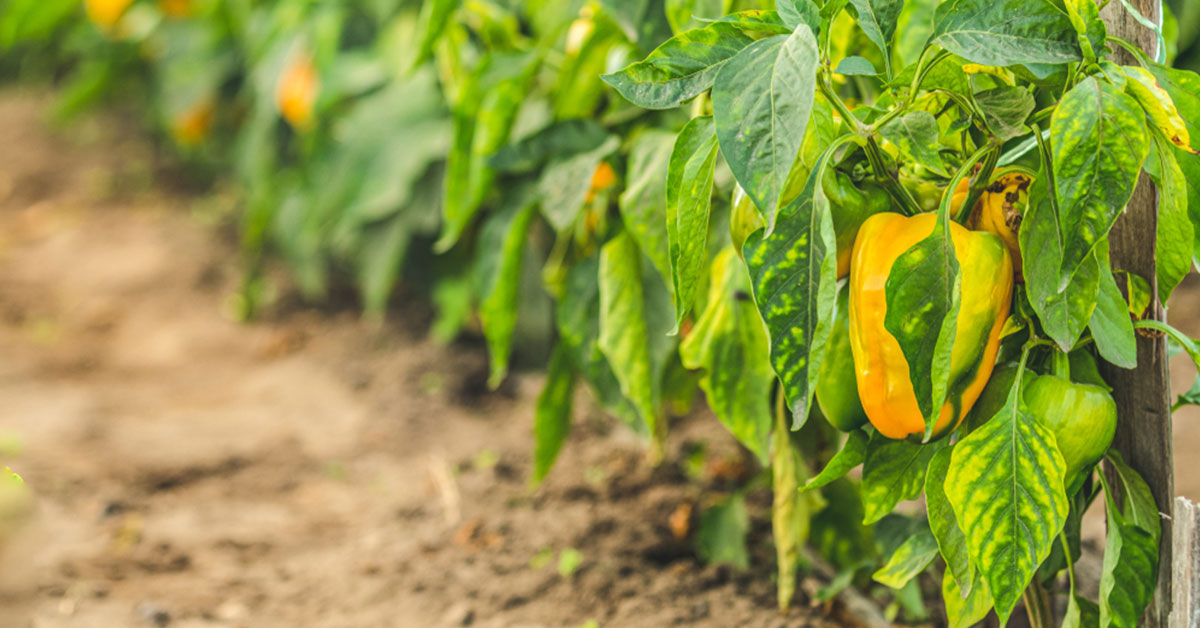Peppers have been the most challenging vegetable for me to grow, so believe me, I’m no stranger to yellow leaves on peppers. It’s happened to me multiple times for multiple reasons. I’ve been through it. So when fellow gardeners email me asking why their pepper plants have yellowing, dying leaves, it’s pretty easy for me to identify why from my extensive experience struggling to grow peppers. In this article, I’ll go over all of the reasons pepper plant leaves turn yellow and how to fix each one.
Causes of yellow pepper leaves
It can be so endlessly frustrating to put time, effort, and most of all, money into our gardens only to have our plants mysteriously start to fail on us. And sadly, we can’t ask them what’s wrong. We have to run down the list of most likely and least likely causes for the problem. There are 7 common reasons for yellow pepper leaves, and most of them have a relatively painless fix. Let’s talk it through.
Not enough water
It’s true that peppers don’t love to be soaked with water all the time, but they also don’t like to be left out of the rain too long. The most common reason for pepper plant leaves turning yellow is insufficient water. The soil is getting too dry, the plants are losing too much water, and the leaves are beginning to die. You can positively diagnose this as the problem by digging a few inches into the ground near your pepper plant. If it’s bone dry, the plants are being underwater. Increase watering your pepper plant to once per week.
Too much water
Similar to not receiving enough water, if pepper plants receive too much water, it can make the leaves on your plants turn yellow. This is likely due to root rot, a fungal infection that kills the roots of your pepper plants. Soggy soil allows root rot spores to breed wildly, damaging your plant’s roots and preventing the uptake of water. If you’ve been overdoing it on the water, stop and allow the soil to completely dry out. Once dry, you can begin a weekly watering schedule. Remember: if it rains a lot where you are, you may not need to water your plants at all.
Insufficient nutrients
Watering-related problems are the two most common causes of yellow pepper leaves. If you’re certain that your watering schedule is on lock and that can’t be the issue, the next most common problem is nutrient deficiency. Peppers need nitrogen for healthy foliage growth and potassium for a strong defense against disease. If your pepper plants are turning yellow, a one-time fertilization with high nitrogen fertilizer might do the trick. The best organic sources I know of are rabbit manure and composted chicken manure. You can also feed a balanced 10-10-10 fertilizer every other week. If your plants are still struggling, you may need to repeat this monthly.
Disease
Disease is something else that can cause yellow pepper leaves, although it is a bit less common than other reasons on this list. Phytophthora blight, bacterial leaf spot, and wilt are the three most common diseases that would cause yellowing leaves. These diseases also have a tendency to have secondary symptoms, like brown spots or wilted leaves in the case of wilt. If you believe your peppers are impacted by a disease, it’s best to remove and destroy the plant and allow that ground to lay fallow for a year.
Pests
Pests aren’t the most common causes of yellow pepper leaves but they certainly tend to be the most obvious cause. Aphids and mites are attracted to pepper plants. They feed on the nutrients and water inside of the leaves and stems of the plants. By the time the leaves of your peppers are turning yellow, the infestation should be pretty advanced and easy to see. The good news is that this is pretty easy to fix. A simple, organic pesticide will take care of it.
You can also use neem oil, which works by coating and suffocating the pests on your plants and reducing their ability to feed on the leaves and stems. Insecticidal soaps will also help control pest outbreaks.
Chlorine in water
Chlorine is the rarest cause of yellow pepper leaves. It typically comes from one of two sources: your tap water or your fertilizer. Fertilizers are known to have some chlorine that can build up in the soil over time. Tap water also contains chlorine. This is a tough problem to fix, because the only way to resolve it is by washing the chlorine out of the soil using non-chlorinated water. In pots, this should be pretty easy to do. A few gallons of purified, non-chlorinated water should get you on the right track. Peppers planted in the ground may struggle to get better.
Cold weather
Finally, yellowing pepper leaves can be caused by cold weather. Peppers are hot weather plants, and although they can survive easily temperatures that drop down to around 40, they prefer it not to drop below 60 degrees Fahrenheit. Be conscientious of the night time temperatures in spring. If it’s still getting close to 40 at night, wait to plant your peppers.
On the other hand, if the summer days are getting shorter and fall is approaching, you can’t really control this part of the natural cycle. Your pepper plants are coming to a close. Setting up a greenhouse over them may prolong the inevitable, but in this case, it sounds like your peppers are dying a natural death, sad to say.













